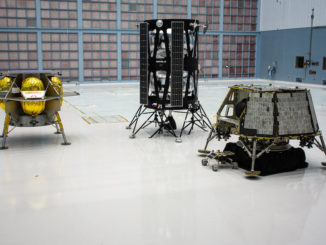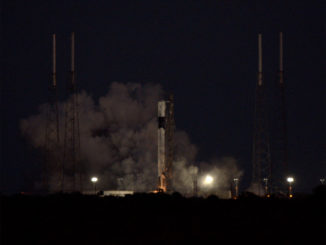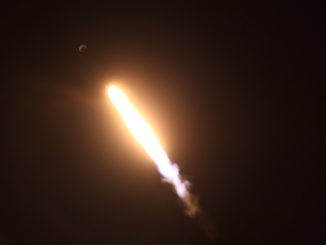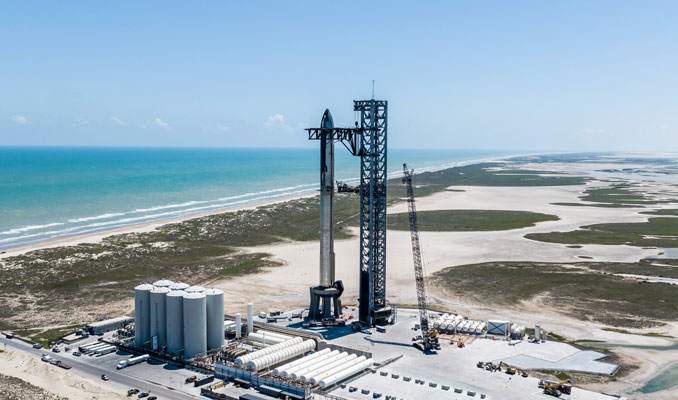
Story updated with information confirmed to Spaceflight Now by the Federal Aviation Administration on Sept. 7, 2023.
Another SpaceX Starship rocket stands fully integrated against the South Texas horizon and company-founder Elon Musk said from his perspective, they’re ready to launch.
Over the course of several hours on Tuesday at its test facility near Boca Chica Beach, SpaceX teams hoisted the Starship upper stage of the rocket, S25, on top of the Super Heavy Booster, dubbed Booster 9 or B9, that was already on the launch mount.
Following the operation, Musk took to his social media platform, X, to declare that “Starship is ready to launch, awaiting [Federal Aviation Administration] license approval.”
While some aviation and marine warning notifications suggest launch could be somewhat soon, the second clause of Musk’s post will be the great determinative factor of when the second launch of a fully integrated Starship rocket will actually take place.
SpaceX submitted its final mishap investigation report to the FAA over the summer, following it’s unsuccessful launch attempt on April 20. It’s part of the SpaceX-led mishap investigation that is being overseen by the FAA.
An agency spokesperson told Spaceflight Now in a statement on July 28 that its oversight is “to ensure SpaceX complies with its FAA-approved mishap investigation plan and other regulatory requirements.”
“A mishap investigation is designed to further enhance public safety. It will determine the root cause of the event and identify corrective actions the operator must implement to avoid a recurrence of the event,” the spokesperson said.
Because of their interests as well, both NASA and the National Transportation Safety Board (NTSB) also have official observer status to the investigation.
How soon is Starship FT2?
Since its first launch in the spring, SpaceX has been busy making updates to both its Starship rocket as well as the infrastructure around the launch pad.
They added a water deluge system at the base of the orbital launch mount to protect the pad from the damage seen during the first launch attempt.
Teams also added a hot staging ring to the top of the Super Heavy booster to alter the way that the first and second stages of the rocket separate during its ascension.
It’s unclear what additional updates and requirements the FAA will require from SpaceX prior to the agency granting Starship another launch license. The timeline is no more certain.
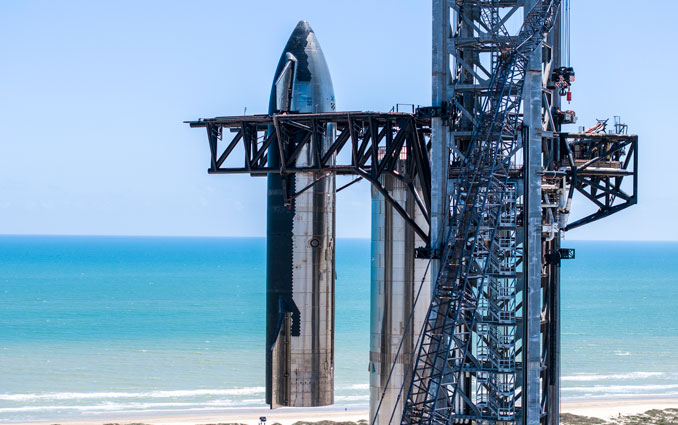
For instance, Blue Origin’s New Shepard rocket experienced what it described as a “thermo-structural failure on the engine nozzle” on its BE-3PM engine, which triggered the Crew Capsule escape system during its flight on Sept. 12, 2022.
At this point, the New Shepard vehicle still has not returned to flight. On Thursday, Sept. 7, 2023, an FAA spokesperson confirmed to Spaceflight Now that its mishap investigation regarding this incident has not concluded.
Regarding SpaceX’s Starship rocket, the FAA stated that its mishap investigation is also still ongoing with no specific timeline.
“The SpaceX Starship mishap investigation remains open. The FAA will not authorize another Starship launch until SpaceX implements the corrective actions identified during the mishap investigation and demonstrates compliance with all the regulatory requirements of the license modification process,” the agency stated.
There is also the outstanding lawsuit brought by the Center for Biological Diversity, the American Bird Conservancy, Surfrider Foundation, Save RGV (Rio Grande Valley) and the Carrizo/Comecrudo Nation of Texas.
According to the most recent court filing on July 25, a joint status report is due to the U.S. District Court for the District of Columbia by Oct. 27, 2023.
Jared Margolis, the lead attorney for the CBD, told Spaceflight Now in a statement on Sept. 6 that the administrative record is set to be filed by the end of September. After the contents of the record are agreed upon, dates for filing summary judgment motions will be established, likely taking place over the fall and winter.

Margolis added that they are also looking at other options “if the FAA allows SpaceX to continue with additional launches before they have complied with the requirements of NEPA (National Environmental Policy Act), including a supplemental analysis to address the [April 20] launch explosion and the subsequent changes to the launch program.”
“As far as the recent tests and the potential for another launch, we believe that such activities violate the National Environmental Policy Act and the Endangered Species Act, both of which require supplemental analysis as described above, and preclude such activities while the supplemental analysis is pending to preserve the status quo,” Margolis told Spaceflight Now. “We therefore remain very concerned that FAA has not made clear that no further launches will be permitted until all applicable environmental laws are complied with.”
Spaceflight Now reached out to the FAA for clarification, but has not yet heard back as of publication.
It’s unclear if, like the FAA mishap investigation, the FAA will require the resolution of the lawsuit before the second test flight of Starship.

